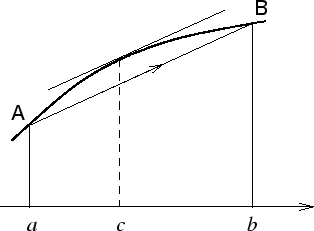If![]() is a differentiable function with a continuous derivative and if
is a differentiable function with a continuous derivative and if![]() are any two points then there is a point
are any two points then there is a point ![]() between
between![]() and
and![]() at which
at which
This result is also `geometrically obvious' once you draw the picture.

Mean Value Theorem: somewhere between a and b , the graph must be parallel to the chord![]()
The expression![]() is just the slope of the chord
is just the slope of the chord![]() So the theorem is saying that there must be a point
So the theorem is saying that there must be a point![]() between
between![]() and
and![]() at which the slope of the graph is equal to the slope of the chord
at which the slope of the graph is equal to the slope of the chord![]()
This may seem very simple--it is very simple--but it is also very important. In most of its applications we think of the result in the following way, which is easily derived.
![]()
(Note that the theorem does not tell us what c is--just that it must be there.)
Here's a simple application of this theorem. Suppose that![]() between
between![]() and
and![]() Then
Then![]() must be positive (whatever c is). So
must be positive (whatever c is). So![]() must be bigger than
must be bigger than![]() So, in an obvious sense, the function must be increasing.
So, in an obvious sense, the function must be increasing.
Here's another typical application. Let![]() Then
Then![]() So we must have
So we must have ![]() This result is rubbish. For example, tan(
This result is rubbish. For example, tan(![]() ) = tan(0) = 0. But 0 - 0 is not bigger than
) = tan(0) = 0. But 0 - 0 is not bigger than![]() - 0. What's gone wrong?
- 0. What's gone wrong?
The problem here is that![]() is not a differentiable function between 0 and
is not a differentiable function between 0 and![]() --it blows up at
--it blows up at![]() When using these theorems, no matter how `obvious' they are, you really must check that the conditions of the theorem are precisely satisfied.
When using these theorems, no matter how `obvious' they are, you really must check that the conditions of the theorem are precisely satisfied.
